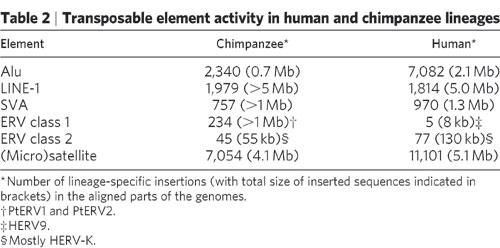- Mar 16, 2004
- 22,030
- 7,265
- 62
- Gender
- Male
- Faith
- Calvinist
- Marital Status
- Single
- Politics
- US-Democrat
Still can't explain why we don't see ERVs shared orthologously between orangutans and humans, but missing from gorilla and chimp, eh mark? Or why the ERVs which do deviate from the nested hierarchy are non-orthologous, as expected by common ancestry?
Your using a couple of terms fast and loose, there is nothing to explain. The ERVs are a protein coding gene graveyard, very few in the human genome that actually work. This is supposed to be some kind of proof but the evidence is so convoluted there is no coherent argument. Still can't explain how:
With more than 100 members, CERV 1/PTERV1 is one of the most abundant families of endogenous retroviruses in the chimpanzee genome. (Genome Biol. 2006).
Or that:
PtERV1-like elements are present in the rhesus monkey, olive baboon and African great apes but not in human, orang-utan or gibbon, suggesting separate germline invasions in these species.

(Initial Sequence of the Chimpanzee Genome, Nature 2005)
Why are the ERVs which are shared by all 4 species among the most mutated? Why are the ones shared only by chimps and humans among the least mutated? Why does this also hold true with LTR divergence?
The evidence is anecdotal at best but if you don't bother with the actual research you don't have to worry about that do you?
Instead of demonstrating how this is remotely possible given the known mutation rate evolutionists would rather talk about this: Phylogenies of seven HERV loci. When 8% of the human genome is made up of ERVs with a 94% nucleotide sequence identity should we really be supprised the seven loci are the same? For HERV-K JML 6.17 they identified 5 substitutions, a couple of them had as many as 10. This is supposed to be some kind of proof?
Here they discuss the probability of the 11 substitutions, assuming they happened by chance:
Although it is possible that any one position may suffer an identical substitution in both LTRs by chance, the probability of 11 positions undergoing identical substitutions in both LTRs is exceedingly low.
Your incredulity is the real diversion here. Because you fail to offer an alternative explanation for the pattern. You simply can't believe, for some reason, that ERVs can be inserted in the germline...despite the fact that USCognito has presented a paper where we are witnessing it happening in REAL TIME with Koalas. And have also been shown examples of ERVs where the mutations were reversed, and resulted in viable viruses.
That's it, the Koalas, that's the extent of ERVs invading germlines and with devastating deleterious effects at that. HIV is a dangerous ERV that invades white blood cells, by all accounts it's deadly dangerous and caused an epidemic in certain circles. Yet we are supposed to believe that 8% of the human genome is the result of them invading sex cells in the germline in the most vulnerable part of the development process because, we want that naturalistic assumption so bad, it doesn't matter what the odds are.
I'm not incredulous, I'm appalled that this would pass for a scientific argument. I've come to admire the science involved and I'm greatly enthusiastic at the level of discovery emerging from the field of genetics. For someone to pass this convoluted hodgepodge of rationalizations and hair brain semantics to pass it off as somehow scientific is ludicrous. It's an affront to anything remotely scientific, I don't understand why you guys aren't embarrassed to make such a baseless homology argument, which is far and away, the worst I've ever seen and I've seen plenty. Charles Darwin must be rolling over in his grave.
Upvote
0



